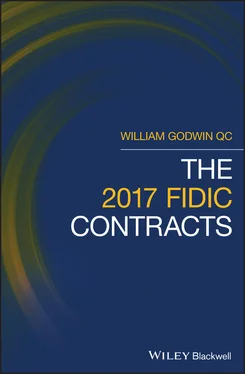3.2.1 Contract Administration in the Three Books: Engineer's/Employer's Representative's Role and Authority
The Engineer/Employer's Representative
Clause 3.1 of the 2017 Red and Yellow Books provides for the appointment of the Engineer and the vesting of all authority necessary to act as the Engineer under the Contract; requirements are also specified for the qualifications and background of the Engineer and fluency in the ruling language as defined in clause 1.4.
The 1999 Red and Yellow Books provide, by clause 3.1, that the Engineer's staff are to include suitably qualified engineers and other professionals competent to carry out the Engineer's duties, but the 2017 Books go further and provide that the Engineer must be a professional engineer with suitable qualifications, experience and competence and fluent in the language of the Contract.
The first editions of the Red and Yellow Books expressly state that the Engineer has no authority to amend the Contract or, except where otherwise provided, authority to relieve either party of any duties, obligations or responsibilities under the Contract (clause 3.1). Clause 3.2 of the 2017 editions contains a very similar provision.
Clause 3.1 of the 2017 Red and Yellow Books provides for the Engineer to be a legal entity rather than an individual or firm. If the Engineer is a legal entity, notice of the natural person appointed and authorised to act on its behalf has to be given (clause 3.1, fourth paragraph).
Clause 3.1 of the 2017 Silver Book requires the Employer to appoint an Employer's Representative, who, unless otherwise stated in the Contract conditions, is to be deemed to act on the Employer's behalf under the Contract. The Employer's Representative is also vested with the full authority of the Employer, except in respect of clause 15 relating to termination of the Contract by the Employer; this contrasts with the Red and Yellow Books, where no such limit on the Engineer's authority applies. Requirements as to competence and the notice to be given if the Employer's Representative is a legal entity are set out in clause 3.1 in terms similar to those in clause 3.1 of the other two Books. 3
Authority and duties
Clause 3.2 of the 2017 Red and Yellow Books sets out the Engineer's duties and authority. He may exercise the authority attributable to the Engineer as specified in or necessarily to be implied from the Contract. If the Engineer is required to obtain the Employer's consent before exercising a specified authority, such a requirement must be stated in the Particular Conditions. However, there is no requirement for the Engineer to obtain the Employer's consent before he exercises his authority under clause 3.7; and the Employer must not impose further constraints on the Engineer's authority. But where the Engineer exercises a specified authority for which the Employer's consent is required, then for the purposes of the Contract such consent is deemed to have been given.
The 2017 Silver Book (like the 1999 edition) states no similar constraints on the Employer with respect to exercise of his Representative's authority, clause 3.2 in both editions dealing only with delegated authority to assistants.
Under clause 3.2 of the 2017 Red and Yellow Books any acceptance, agreement, approval, instruction, notice, no‐objection and the like by the Engineer, his representative or any assistant does not relieve the Contractor of any duty, obligation or responsibility which he has under or in connection with the Contract. This provision of clause 3.2 in the 2017 editions is similar to the terms of clause 3.1(c) of the 1999 editions of the Red and Yellow Books.
Clause 3.3 of the 2017 and 1999 Silver Book relates to delegated persons (including the Employer's Representative) and provides that any approvals, acceptances, notices and the like do not, unless otherwise stated, relieve the Contractor of any of his responsibilities under or in connection with the Contract (see further below).
Engineer's Representative/assistants
Clause 3.3 of the 2017 Red and Yellow Books provides for the Engineer to appoint, if he wishes to do so, an Engineer's Representative to whom authority may be delegated to act on his behalf at the site. Clause 3.4 provides for the delegation of duties and authority to assistants, with the limitation, however, that the Engineer may not delegate authority to act under clause 3.7 or to give a notice to correct under clause 15.1. 4 Each assistant's authority is to be carefully defined by reference to the notice delegating the relevant authority; in particular his or her authority to issue instructions to the Contractor extends only to the extent defined in the Engineer's notice of delegation under clause 3.4.
Clause 3.2 of the 2017 Silver Book provides for the appointment, by a notice to the Contractor, of assistants to whom authority may be delegated by the Employer or Employer's Representative, subject however to the Employer's Representative's being unable to delegate authority to act under clause 3.5 (determinations) or to issue a notice to correct under clause 15.1. Clause 3.3 limits the extent of any delegated authority to what is defined in a notice under clauses 3.1 (relating to the Employer's Representative) or 3.2 (other Employer's personnel) and provides that the Contractor is not to be relieved of any duty or responsibility by a delegated person's (including the Employer's Representative's) acceptance, agreement, approval, instruction, notice, no‐objection and the like (in accordance with the notice of delegation), unless otherwise stated in the delegated person's communication relating to such an act.
Clause 3.5 of the 2017 Red and Yellow Books and clause 3.4 of the 2017 Silver Book deal with the Engineer's/Employer's instructions in largely the same way. This contrasts with the 1999 editions of the three Books, most noticeably in that in the Red Book the Engineer's instructions did not have to be in writing, although he was meant to give his instructions in writing wherever this was practicable. Provision was then made in clause 3.3 for confirmation of oral instructions, the confirmation then to be taken as constituting the Engineer's written instruction. In the 2017 editions of all three Books instructions must be in writing by virtue of clause 1.3, which expressly provides for instructions to be in writing and to comply with the other requirements of that clause.
Another difference between the 1999 editions of the three Books is that the instructions which the Engineer, in the Red and Yellow Books, might issue were to be instructions which may be necessary ‘… for the execution of the Works and the remedying of any defects, all in accordance with the Contract’ (clause 3.3). In the 1999 Silver Book, on the other hand, the instructions which the Employer might issue were to be instructions which may be necessary ‘… for the Contractor to perform his obligations under the Contract’ (clause 3.4).
In the 2017 editions of all three Books this wording has been replaced by a uniform wording: instructions may be issued where they are necessary ‘… for the execution of the Works, all in accordance with the Contract’. Thus the 2017 editions adopt the wording of the 1999 Red and Yellow Books with respect to the scope of instructions under the Contract, deleting however the words ‘… and of the remedying of any defects’.
It has been suggested by some commentators that this creates a difficulty, in that it is now unclear whether, strictly speaking, the Engineer or Employer is authorised to issue instructions for the remedying of defects. There does not, however, appear to be such a difficulty in reality since clause 7.6 of the three 2017 Books expressly entitles the Engineer or Employer to issue instructions at any time before taking over of the works to repair or remedy plant or materials not in accordance with the Contract, any other works which are not in accordance with the Contract and to carry out any remedial work urgently required for the safety of the works; and clause 7.5 in the three 2017 Books contains provision for notices to be given in respect of defective works as a result of examination, inspection, measurement or testing of any plant, materials, design or workmanship, with a power in the Engineer or Employer to give instructions under clause 7.6 where necessary. To have retained the old wording might, indeed, have generated confusion as to the appropriate clause under which an instruction to remedy defects prior to taking over might be given. Rather than retaining the old reference to the general power to issue instructions to remedy any defects, the 2017 editions have made the exercise of that power specific to clauses 7.5 and 7.6; in relation to defects dealt with after taking over, the provisions relating to the Defects Notification Period apply.
Читать дальше












